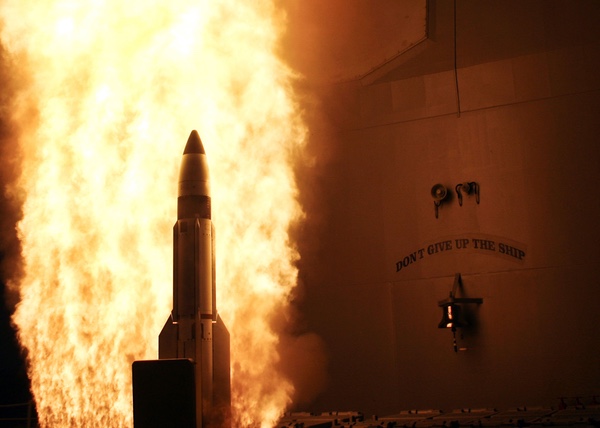Burning Frost, the view from the ground: shooting down a spy satellite in 2008by Dwayne A. Day
|
| In 2007, Johnson’s expertise led him to be involved in the decision-making over what to do about USA-193. |
During the 1980s, Johnson was the editor of a publication called The Soviet Year in Space. First published in 1983, it appeared annually until 1990, at which point the name was changed to Europe and Asia in Space and published in 1992 and 1994, before publication ceased. The Soviet Year in Space was an unclassified report based on open sources and covering Soviet space activities for the previous year. It was an invaluable resource for understanding how Soviet space efforts were evolving and improving. It was produced under contract for the Department of Defense and proved to be a highly reliable source of unclassified information on its topic.
Johnson was an expert on orbital debris, and after the cessation of the publication in the 1990s, he began working as NASA’s Chief Scientist for Orbital Debris. In 2007, his expertise led him to be involved in the decision-making over what to do about USA-193.
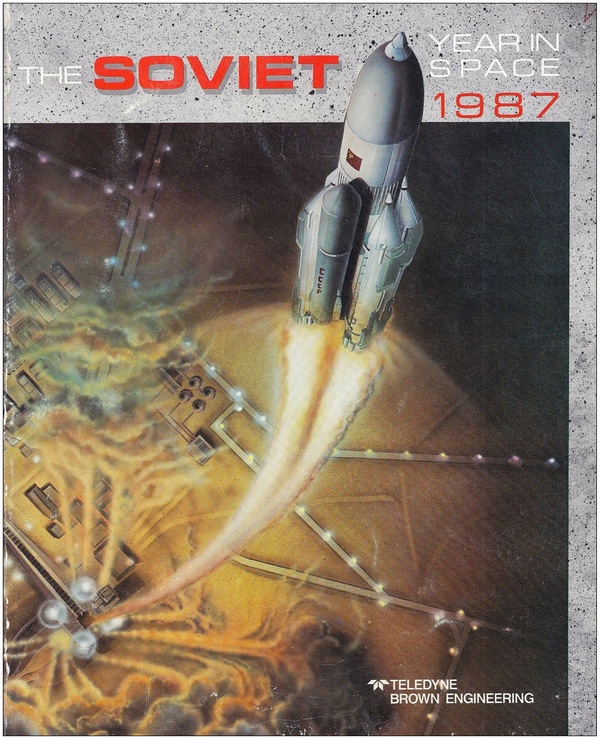 Johnson was the lead author on a well-regarded series of books on the Soviet space program throughout the 1980s and into the 1990s. (credit: Amazon) |
Broken spysat, dangerous spysat
USA-193 was a National Reconnaissance Office (NRO) satellite launched into low Earth orbit by a Delta II rocket on December 14, 2006. It was a top-secret satellite, apparently of a new or experimental design based upon its unique launch vehicle (rarely used by the NRO) and orbital inclination. Although the launch was successful, ground controllers soon lost contact with the satellite.
In his article, Johnson explained that he was involved in the issue almost from the start. “As NASA’s Chief Scientist for Orbital Debris, my role in what was to become Operation Burnt Frost actually began a year before this initially highly classified project was even envisioned,” he wrote. The NRO had very little data to determine why their satellite had died. “Theoretically, the spacecraft could have been struck in a vital location by another object. Therefore, the probability of a hit by a meteoroid or a piece of orbital debris needed to be examined,” Johnson wrote. “Thus, a month after the launch of USA-193, a representative of the NRO contacted me with a request for assistance. The NASA Orbital Debris Program Office at the Johnson Space Center supported this assessment for the next few months. In the course of this work, I raised the issue of the eventual reentry of USA-193.”
The spacecraft was in a relatively low orbit and would reenter within a couple of years. There was a possibility it might rain debris down on a populated area. “I suggested that the NRO consider its position and the best way forward. In the spring of 2007, NASA provided software to the NRO to conduct an initial moderate fidelity assessment of the survivability of USA-193 parts.”
Because the satellite was brand new when it failed, it had not consumed any of its propellants. As Johnson explained:
The spacecraft carried 1000 pounds of hydrazine propellant in an approximately spherical titanium tank with a diameter of more than 3 feet. Such tank materials and propellants are commonly used in spacecraft propulsion systems. Moreover, titanium has a high melting temperature, and titanium tanks routinely survive reentry. Several have been recovered after reentry with very little structural damage. However, the USA-193 situation was unprecedented. First, previous titanium tanks had begun the reentry process empty or nearly empty of their propellants. The presence of 1000 pounds of hydrazine would affect the ballistic characteristics of the tank, which in turn might alter the fate of the tank. Of even greater importance, however, was a conclusion by spacecraft engineers that the hydrazine was very likely in a deeply frozen state. This complicated the reentry survivability calculation immensely.
Johnson explained that the classified nature of the satellite limited who could do analysis of it. Some NASA personnel who were experts in the subject of reentry survivability lacked the security clearances to review the relevant data and were confined to doing parametric analyses.
 Nicolas Johnson, who died in April 2021, played a key role in assessing the risk from the disabled American reconnaissance satellite. (credit: Tullahoma News) |
The Commander of US Strategic Command (USSTRATCOM), General Kevin Chilton, was a former astronaut and therefore very familiar with NASA. In early December 2007, the Director of the National Reconnaissance Office, Scott Large, contacted Chilton about the possibility of mitigating the reentry risk of the satellite. Chilton told Large to contact General Henry Obering, head of the Missile Defense Agency. By this time, the satellite was expected to reenter in three months. “Contrary to popular belief, the United States did not possess an anti-satellite (ASAT) capability that could address the USA-193 situation,” Johnson wrote, although MDA had used Navy missiles to successfully intercept high-altitude missiles.
Johnson added that in 1979 he had joined the United States’ last ASAT development program, a project using a missile launched from an F-15 Eagle to intercept low orbiting satellites that was successfully tested against the Solwind satellite in 1985. Johnson said that he “was present in the Space Surveillance Center in Cheyenne Mountain, Colorado, following the interception of Solwind to monitor the debris consequences of the engagement. This test did demonstrate the potential collateral effects of the physical destruction of objects in space by creating large amounts of debris.” (See: “Sword and shield: defending against an American anti-satellite weapon during the Cold War,” The Space Review, June 14, 2021)
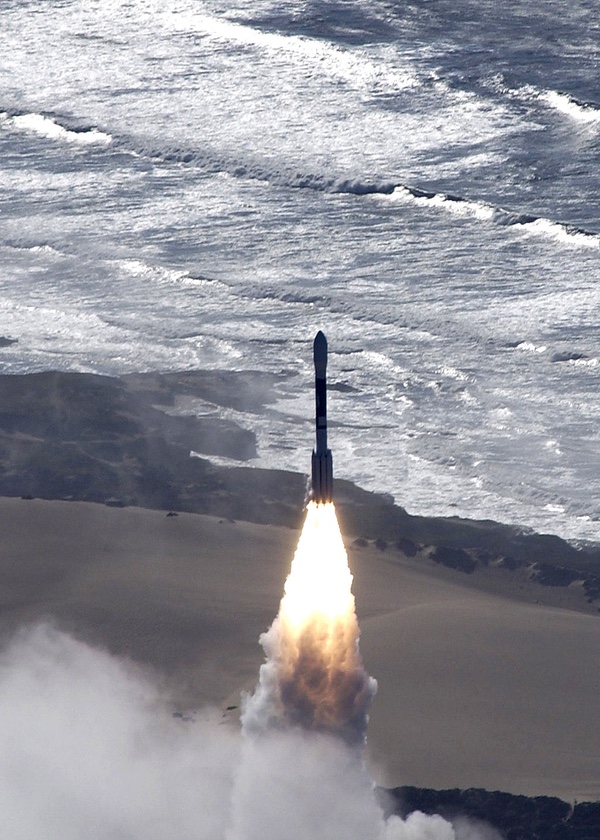 Launch of the National Reconnaissance Office satellite USA-193 in December 2006. This satellite malfunctioned upon reaching orbit. (credit: Wikipedia) |
Presidential authorization
The clock was ticking on USA-193. On January 8, 2008, President George W. Bush was briefed on the situation and potential options. “The emphasis during that briefing was on the human casualty risk,” Johnson wrote. The satellite with its hydrazine fuel could fall on anyone living between 58.5 degrees north and 58.5 degrees south latitude, which included most of the world’s population.
| There was another factor if they chose to intercept the satellite with a missile: debris could reach the orbit of the International Space Station. The shuttle Atlantis was also scheduled for a February 7 launch to the ISS. |
The day after the meeting with President Bush, NASA held a classified meeting at Johnson Space Center to discuss the agency’s role. NASA Administrator Mike Griffin, JSC Director Michael Coats, Johnson, and a few others were in the meeting and DoD personnel joined in by secure communications. Griffin placed NASA resources at the group’s disposal, designating Johnson as technical liaison to the interagency working group. Johnson explained: “NASA’s initial tasks included the following: (1) evaluation of the risk that the satellite propellant tank would pose to people on Earth if it reentered the atmosphere intact, (2) determination of the near-term risk to the International Space Station (ISS) and other operational satellites from debris released in the destruction of USA-193, and (3) prediction of the longevity of any USA-193 debris that remained in orbit. The first task was by far the most difficult.”
The risk was not simply that the spacecraft could fall on top of somebody, but that after it reached the ground any gaseous hydrazine would vent and spread out over a large area. Hydrazine is very dangerous. “At low concentrations of the gas, near-term discomfort or long-term human tissue damage was possible. At higher concentrations, the exposure could be fatal. Of course, with time the hydrazine gas would dissipate and no longer pose a threat.”
There was another factor if they chose to intercept the satellite with a missile: debris could reach the orbit of the International Space Station. The shuttle Atlantis was also scheduled for a February 7 launch to the ISS, returning on the 18th. General Chilton had flown on three shuttle missions and was acutely aware of the dangers to the shuttle. He chose to delay any attempt to intercept the satellite until after the shuttle was safely on the ground. This meant that the opportunity to shoot down the satellite lasted only from February 18 until early March, when USA-193 would reenter on its own. “Attempting an intercept in the last few days before reentry was problematic because of potential inaccuracies in both targeting and spacecraft signature data,” Johnson added.
NASA produced final casualty risk assessment figures in event of an uncontrolled reentry of the satellite. “The risks were by far the highest ever associated with a spacecraft or rocket body reentry,” Johnson stated. President Bush approved the intercept.
There was still a possibility that the missile might miss or might strike a glancing blow, such that the propellant tank would still survive and reach the ground. The interagency group created a “Consequence Team” to deal with such an event and it eventually included four C-17 aircraft and 90 people.
While the preparations were being made, Atlantis was launched and reached the ISS. After several days in orbit, NASA extended its mission by two days, scheduling the landing on February 20. According to Johnson, “Although the period to launch an interceptor against USA-193 was already short, no effort was made to influence the duration of the Space Shuttle flight.”
On February 14, 2008, the US government announced the plan to intercept USA-193 with a missile. Johnson wrote that President Bush insisted on the need to be transparent about the rationale for the operation. Congress was briefed before it recessed for the President’s Day holiday.
The intercept was to be conducted by an SM-3 missile launched from a US Navy cruiser. Three missiles and ships were modified from a ballistic missile defense role, a capability that the Navy had improved significantly in recent years before the operation. “A naval platform had been selected, in part, for its great mobility, which was important because the path of USA-193 shifted every day with respect to the ground. If a launch opportunity had to be deferred for some reason, especially if the cause was ship-related, another ship could be in position to take the next day’s shot,” Johnson wrote. “Even more importantly, the use of a naval platform permitted the selection of precisely where the engagement would occur. After a successful engagement about half of the resultant debris would reenter the dense portion of the atmosphere within about an hour. Therefore, a downrange ground-track could be chosen to maximize the amount of surviving debris over broad ocean areas or sparsely populated regions, reducing the residual human casualty risk from solid debris.” The reentry experts also calculated that 99% of the debris left in orbit would reenter the atmosphere within a week. What Johnson did not add in his article was that the Navy had successfully used the SM-3 in a series of missile defense tests during previous years and it was now well-proven.
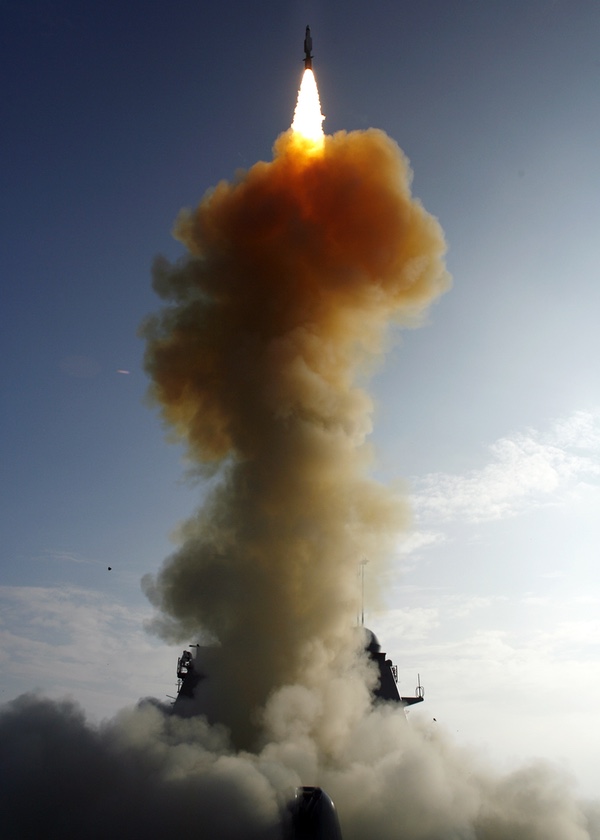 Launch of the missile from USS Lake Erie that intercepted USA-193. |
USS Lake Erie bags a satellite
Atlantis landed in Florida on the morning of February 20. The interagency group decided that it was now safe to carry out the operation. “At 10:26 p.m. EST, an SM-3 missile was launched from the USS Lake Erie located north of Hawaii. Four minutes later, USA-193 was impacted at high speed. The collision between missile and satellite had occurred at an altitude of approximately 150 miles while the latter was traveling in a northeasterly direction toward northern Canada.”
The United States soon released radar, optical, and infrared images of the interception. No debris was found. According to Johnson, “Geopolitically, the President and his national security advisors were well aware of how the U.S. actions could be misconstrued. In fact, this was a major argument considered, but rejected, in the interagency community for not attempting to destroy the satellite. Even if the mission had not succeeded, the United States would undoubtedly still have been accused of a military objective.”
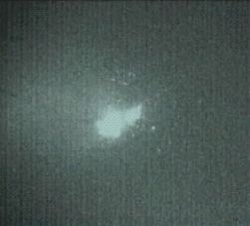 Interception of the USA-193 satellite in low Earth orbit. |
Johnson also argued that the United States did not need to prove that it could intercept a satellite because it had done so before, with the Homing Overlay Experiment in 1985 and the F-15 ASAT test against the Solwind satellite in 1985. “Hence, merely repeating such a test offered little or no gain, especially since the SM-3 missile was not tied to a formal ASAT program. In fact, the SM-3 would be completely inadequate for an ASAT weapon system because of its inherent flight performance limitations.”
| Johnson was also dismissive of unnamed “experts” that claimed that the justification of eliminating the dangerous hydrazine was a ruse, covering up the real goal of demonstrating American ability to shoot down a satellite in response to China. |
Johnson argued that the event was an excellent demonstration of American capabilities. “Undertaking such a stressing scenario with no preparation, only a 2-month timeline, and extremely difficult conditions is not a hallmark of the development of a new major weapons system,” he wrote.
Johnson was also dismissive of unnamed “experts” that claimed that the justification of eliminating the dangerous hydrazine was a ruse, covering up the real goal of demonstrating American ability to shoot down a satellite in response to China. He was also scornful of those who claimed that the hydrazine tank would not reach the ground. “The NASA Orbital Debris Program Office is not only the agency’s center of excellence for assessing the uncontrolled reentry of unmanned satellites and rocket bodies, but it provides support to other federal organizations and the aerospace industry in this highly technical discipline,” he wrote. “The fact that concern about the potential hazard posed by the hydrazine tank dated back to the summer of 2007 also refutes the suggestion that human safety was a last-minute cover story for the mission. In countless highly classified in-person meetings and videoconferences up to the most senior levels of the U.S. government, not once did I ever hear of a reason to consider taking mitigation measures against USA-193 other than to protect human life. To do nothing in the face of this threat would have been much easier.”
Johnson concluded his article by writing: “Gen. Chilton has said that only the United States could have achieved such a demanding action in such a short time. I believe that only the United States would have even tried.”
ASATs, now and again
Johnson’s account adds new perspective and information to the story of Operation Burnt Frost. Many of the details in his article have been published before. There is an extensive Wikipedia entry on Operation Burnt Frost and even a 2008 Military Channel documentary “Satellite Shootdown” (available on YouTube). The Wikipedia entry contains links to several contemporaneous articles about the interception including the opinions of critics stating that it was difficult to accept that the effort was not a response to China’s much-criticized ASAT test a year earlier.
Johnson clearly wrote his account to support his viewpoint that only a concern for risk to human life was behind the operation. He noted that one reason not to do the interception was the inevitable international criticism. He stated that an unnamed representative of a major spaceflight nation even complimented him on the United States’ willingness to deal with the safety hazard created by USA-193. Johnson did not mention in his article that both China and Russia criticized the US action.
| According to Johnson, the modifications made to the missiles and the ships were temporary and not incorporated into the ballistic missile fleet. But the fact that the modifications were developed and deployed so quickly proved that it could be done again if necessary. |
Johnson saw the operation from a debris hazard perspective. He was not involved in the international relations discussions about the operation. What we do not have—and probably will not see for decades—are any classified discussions of the operation’s political aspects. One issue that Johnson did not discuss is why, if he raised the issue of spacecraft reentry in early 2007, it took a full year before a decision to shoot it down. Did the Chinese ASAT test in 2007 make the satellite shootdown more politically acceptable (or at least palatable)? Or did it simply take nearly a full year to complete the risk analysis? Although concern about risk may have initiated and propelled the operation, did anybody in the Bush administration express the viewpoint that Burnt Frost would be politically useful as a response to China’s ASAT test? Somebody involved, probably at the National Security Council, certainly drafted a list of pros and cons of the operation from an international affairs standpoint. It is possible that “Burnt Frost will be perceived as a demonstration of an American ASAT capability” made it into both the con and the pro column, and was viewed as a positive outcome to some in the Bush administration.
Johnson also wrote that there was no need to demonstrate an American ASAT capability because one had already been demonstrated in 1985. But that system had been retired decades earlier, and no current American ASAT capability was public until Operation Burnt Frost.
According to Johnson, the modifications made to the missiles and the ships were temporary and not incorporated into the ballistic missile fleet. But the fact that the modifications were developed and deployed so quickly proved that it could be done again if necessary. The SM-3 missile, however, could not reach much higher than it did during the operation and therefore had a very limited ASAT capability. But in the 13 years since Burnt Frost, the United States has certainly acquired other capabilities, and the USS Lake Erie and her sister ships—and their SM-3 missiles—remain in service.
Note: we are using a new commenting system, which may require you to create a new account.
